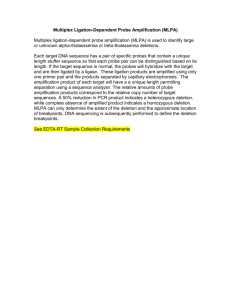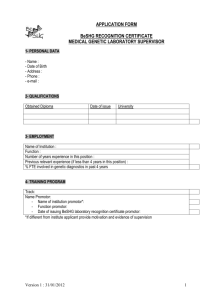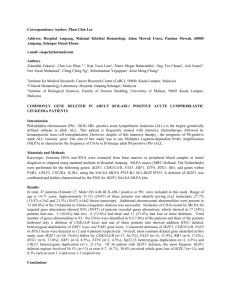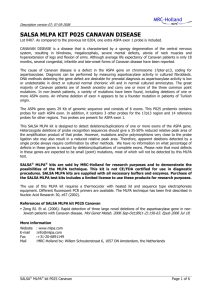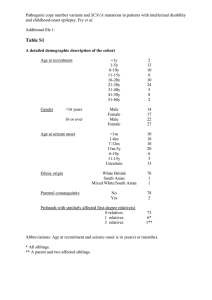MRC-Holland SALSA MLPA KIT P005-B1 Human
advertisement
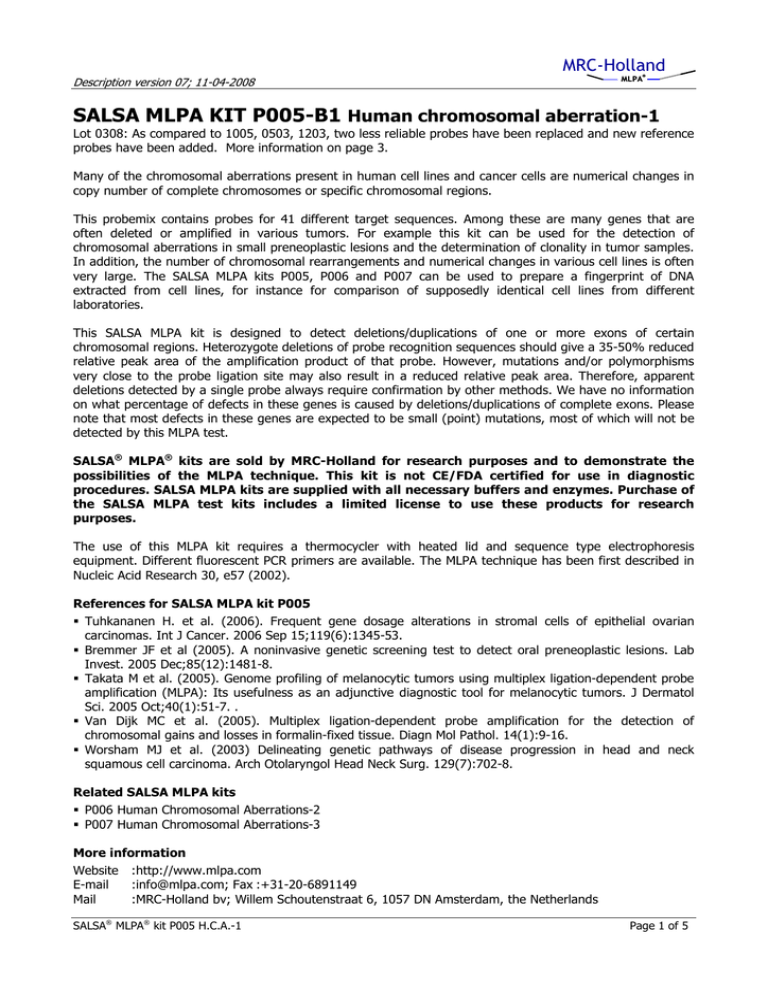
MRC-Holland ® Description version 07; 11-04-2008 MLPA SALSA MLPA KIT P005-B1 Human chromosomal aberration-1 Lot 0308: As compared to 1005, 0503, 1203, two less reliable probes have been replaced and new reference probes have been added. More information on page 3. Many of the chromosomal aberrations present in human cell lines and cancer cells are numerical changes in copy number of complete chromosomes or specific chromosomal regions. This probemix contains probes for 41 different target sequences. Among these are many genes that are often deleted or amplified in various tumors. For example this kit can be used for the detection of chromosomal aberrations in small preneoplastic lesions and the determination of clonality in tumor samples. In addition, the number of chromosomal rearrangements and numerical changes in various cell lines is often very large. The SALSA MLPA kits P005, P006 and P007 can be used to prepare a fingerprint of DNA extracted from cell lines, for instance for comparison of supposedly identical cell lines from different laboratories. This SALSA MLPA kit is designed to detect deletions/duplications of one or more exons of certain chromosomal regions. Heterozygote deletions of probe recognition sequences should give a 35-50% reduced relative peak area of the amplification product of that probe. However, mutations and/or polymorphisms very close to the probe ligation site may also result in a reduced relative peak area. Therefore, apparent deletions detected by a single probe always require confirmation by other methods. We have no information on what percentage of defects in these genes is caused by deletions/duplications of complete exons. Please note that most defects in these genes are expected to be small (point) mutations, most of which will not be detected by this MLPA test. SALSA® MLPA® kits are sold by MRC-Holland for research purposes and to demonstrate the possibilities of the MLPA technique. This kit is not CE/FDA certified for use in diagnostic procedures. SALSA MLPA kits are supplied with all necessary buffers and enzymes. Purchase of the SALSA MLPA test kits includes a limited license to use these products for research purposes. The use of this MLPA kit requires a thermocycler with heated lid and sequence type electrophoresis equipment. Different fluorescent PCR primers are available. The MLPA technique has been first described in Nucleic Acid Research 30, e57 (2002). References for SALSA MLPA kit P005 Tuhkananen H. et al. (2006). Frequent gene dosage alterations in stromal cells of epithelial ovarian carcinomas. Int J Cancer. 2006 Sep 15;119(6):1345-53. Bremmer JF et al (2005). A noninvasive genetic screening test to detect oral preneoplastic lesions. Lab Invest. 2005 Dec;85(12):1481-8. Takata M et al. (2005). Genome profiling of melanocytic tumors using multiplex ligation-dependent probe amplification (MLPA): Its usefulness as an adjunctive diagnostic tool for melanocytic tumors. J Dermatol Sci. 2005 Oct;40(1):51-7. . Van Dijk MC et al. (2005). Multiplex ligation-dependent probe amplification for the detection of chromosomal gains and losses in formalin-fixed tissue. Diagn Mol Pathol. 14(1):9-16. Worsham MJ et al. (2003) Delineating genetic pathways of disease progression in head and neck squamous cell carcinoma. Arch Otolaryngol Head Neck Surg. 129(7):702-8. Related SALSA MLPA kits P006 Human Chromosomal Aberrations-2 P007 Human Chromosomal Aberrations-3 More information Website E-mail Mail :http://www.mlpa.com :info@mlpa.com; Fax :+31-20-6891149 :MRC-Holland bv; Willem Schoutenstraat 6, 1057 DN Amsterdam, the Netherlands SALSA MLPA kit P005 H.C.A.-1 Page 1 of 5 MRC-Holland ® Description version 07; 11-04-2008 MLPA Data analysis The P005-B1 probemix contains 41 different probes with amplification products between 130 and 472 nt. In addition, it contains 7 control fragments generating an amplification product smaller than 120 nt: four DNA Quantity fragments (Q-fragments) at 64-70-76-82 nt and three DNA denaturation control fragments (Dfragments) at 88-92-96 nt. More information on how to interpret observations on these control fragments can be found in the MLPA protocol. Data generated by this probemix should be normalized with a more robust method. The signals of all probes should be intra-normalized against every single probe separately, thereby creating as many ratios as there are probes. The median of all produced ratios gives an estimate of the final probe ratio, or ploidy status, of the sample’s probes sequences in an MLPA mix. This way, the signal of each probe will be used as a normalization constant (Population normalization). With the normalization constant, the ratio of each probe between reference and patient sample is determined. When only small numbers of samples are tested, visual comparison of peak profiles should be sufficient to easily identify exon deletions. Comparison of results should preferably be performed within one experiment. Only samples purified by the same method should be compared. Confirmation of most exons deletions and amplifications can be done by e.g. Southern blots, long range PCR or FISH. For a small number of genes, including TP53, CCND1, MYC and ERBB2, more than one probe is present in the three SALSA MLPA human chromosomal aberration kits. The three different ERBB2 probes are identical to the three probes in our SALSA MLPA kit P004 ERBB2. The Mapview36 location is the distance in Mb towards the P-telomere according to the NCBI database MapView Build 36, which was released in May 2006. Info/remarks/suggestions for improvement: info@mlpa.com. SALSA MLPA kit P005 H.C.A.-1 Page 2 of 5 MRC-Holland ® MLPA Description version 07; 11-04-2008 SALSA MLPA P005-B1 Human chromosomal aberration-1 probemix Length (nt) 64-70-76-82 88-92-96 130** 136 142 148 154 160 166 175 184 193 202** 211 220 229 238 247 256 265* 274 283 292 301 310 319 328 337 346 355 364 373 382 391† 400 409 418 427 436 445 454** 463 472 SALSA MLPA probe Gene Chromosomal Position Genbank MAP-VIEW 36 Q-fragments: DNA quantity; only visible with less than 100 ng sample DNA D-fragments: Low signal of 88 or 96 nt fragment indicates incomplete denaturation 00838-L12632 00981-L00566 00675-L00146 00798-L00316 00513-L00093 00845-L00378 00429-L00640 00477-L00060 00851-L00464 00612-L00050 00602-L09528 01036-L00609 00670-L00379 00434-L00020 00672-L00169 00841-L00359 00518-L00098 11499-L12634 00468-L00051 00438-L00003 00519-L00099 00348-L00174 00495-L00070 01017-L00322 00346-L00172 00442-L00380 01044-L00607 00452-L00360 01018-L00334 01046-L00624 00443-L00022 10372-L12633 00606-L00008 00820-L00338 00714-L00140 00585-L00150 00596-L00083 00678-L00124 00597-L06724 00979-L00568 01032-L00604 BCL2 CREM ERBB2 ABCC4 IL4 RB1 ABCB1 RELA UTY IL10 CDKN2A RECQL4 TANK EMS1 MYC MYB IL1A PIK3CA IL13 BRCA1 MIF BAX LRMP CDH2 F3 HRAS PTP4A3 BRCA2 STCH FGFR1 CDH1 CRK STK15/STK6 PDCD8 BCAR3 CDKN1A LMO2 TNFRSF7 TIMP2 RENT2 NRAS 18q21.33 10p12.1 17q12 13q32 5q31.1 13q14.2 7q21.1 11q13 Yq11.21 1q32.1 9p21 8q24.3 2q24.2 11q13 8q24.12 6q23 2q13 3q26.3 5q31.1 17q21.31 22q11.23 19q13.33 12p12.3 18q11.2 1p22.1 11p15.5 8q24.3 13q12.3 21q11.2 8p11.2 16q22.1 17p13.3 20q13.31 Xq25 1p22.1 6p21.2 11p13 12p13.31 17q25.3 10p14 1p13.2 M14745 NM_001881 X03363 NM_005845 M13982 L1487 AF016535 L19067 NM_007125 U16720 L27211 AB006532 U59863 M98343 X00364 U22376 X02851 Z29090 X69079 U14680 L10612 L22473 U10485 M34064 M16553 J00277 NM_007079 U43746 U04735 M34185 NM_004360 D10656 AF011468 NM_004208 U92715 L25610 X61118 NM_001242 M32304 NM_015542 X02751 18-058.9 10-035.5 17-035.1 13-094.5 05-132.0 13-047.9 07-087.1 11-065.2 Y-014.1 01-205.0 09-022.0 08-145.7 (0.5 Mb from telomere) 02-161.8 11-070.0 08-128.8 06-135.6 02-113.2 03-180.4 05-132.0 17-038.5 22-022.6 19-054.2 12-025.2 18-023.8 01-094.8 11-000.5 08-142.5 13-031.8 21-014.7 08-038.4 16-067.4 17-001.3 20-054.4 X-129.1 01-093.8 06-036.8 11-033.8 12-006.4 17-074.4 10-012.0 01-115.1 * New in lot 0803. Replaces the less reliable PIK3CA probe from previous lots. ** Small change in length or peak height, no change in sequence detected as compared to older lots. † New in lot 0803. Replaces the less reliable CRK probe that was present in previous lots. Note: Please notify us of any mistakes: info@mlpa.com. SALSA MLPA kit P005 H.C.A.-1 Page 3 of 5 MRC-Holland ® MLPA Description version 07; 11-04-2008 SALSA MLPA P005-B1 probes in chromosomal order Length (nt) HUGO Chromosomal position MAP-VIEW 36 418 328 472 193 256 220 265* 274 154 427 247 166 373 238 346 211 202 463 136 337 436 175 229 445 310 355 160 148 382 391* 142 283 454 319 130 301 400 364 292 409 184 BCAR3 F3 NRAS IL10 IL1A TANK PIK3CA IL13 IL4 CDKN1A MYB ABCB1 FGFR1 MYC PTP4A3 RECQL4 CDKN2A RENT2 CREM HRAS LMO2 RELA EMS1 TNFRSF7 LRMP BRCA2 RB1 ABCC4 CDH1 CRK ERBB2 BRCA1 TIMP2 CDH2 BCL2 BAX STK15/STK6 STCH MIF PDCD8 UTY 1p22.1 1p22 1p13.2 1q31 2q14 2q24 3q26.3 5q31 5q31.1 6p21.2 6q22 7q21 8p11.2 8q24.12 8q24.3 8q24.3 9p21 10p14 10p12.1 11p15.5 11p13 11q13 11q13 12p13 12p12.3 13q12.3 13q14.3 13q32 16q22.1 17p13.3 17q21.1 17q21 17q25 18q11.2 18q21.3 19q13.3 20q13.3 21q11 22q11.23 Xq25 Yq11.21 01-093.8 01-094.8 01-115.1 01-205.0 02-113.2 02-161.8 03-180.4 05-132.0 05-132.0 06-036.8 06-135.6 07-087.1 08-038.4 08-128.8 08-142.5 08-145.7 (0.5 Mb from telomere) 09-022.0 10-012.0 10-035.5 11-000.5 11-033.8 11-065.2 11-070.0 12-006.4 12-025.2 13-031.8 13-047.9 13-094.5 16-067.4 17-001.3 17-035.1 17-038.5 17-074.4 18-023.8 18-058.9 19-054.2 20-054.4 21-014.7 22-022.6 X-129.1 Y-014.1 * New as compared to previous lots. Note: Please notify us of any mistakes: info@mlpa.com. SALSA MLPA kit P005 H.C.A.-1 Page 4 of 5 MRC-Holland ® Description version 07; 11-04-2008 MLPA SALSA MLPA kit P005-B1 H.C.A.-1 sample pictures Figure 1. Capillary electrophoresis pattern from a sample of approximately 50 ng human control male DNA analyzed with SALSA MLPA kit P005-B1 H.C.A.-1 (lot 0308). Figure 2. Capillary electrophoresis pattern from a sample of approximately 50 ng human control female DNA analyzed with SALSA MLPA kit P005-B1 H.C.A.-1 (lot 0308). SALSA MLPA kit P005 H.C.A.-1 Page 5 of 5
